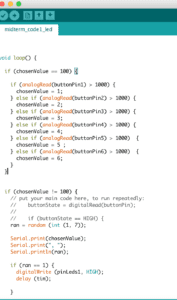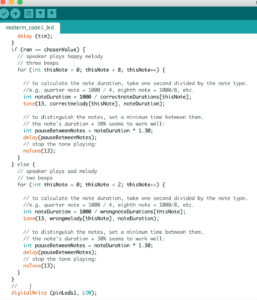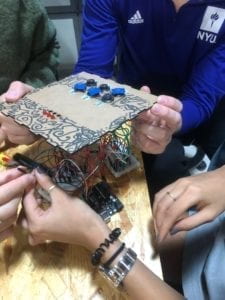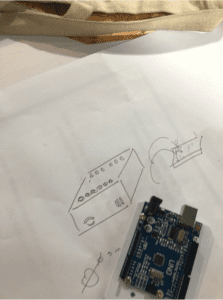Individual Reflection
El Suertudo was not inspired by just one, but a handful of different interactive projects. The classic game of Bop-It inspired our original idea however we realized that only encouraged player to device interaction. In the game players would be tested on correctly following prompts outputted by the device and their actions would be counted as inputs.This was a very good example of interaction We started thinking about what we wanted out of our project in terms of interactivity and soon came to the conclusion that we hoped it would not only be used for device to user interaction but person to person interaction as well.We wanted an input, output and processing from the device but the user and other around as well. This is where the idea of El Suertudo was born. We started off thinking about traditional games we’d play in groups that weren’t exactly tech related but were associated with peer to peer interaction. We finalized on the idea of dice games and its duplicity as a useful decision making tool and staple in many group games. This project mixes traditional games with technology as well as contradicts the notion that technology hinders human to human interaction.
When making El Suertudo we ensured to keep usability in mind. We ensured that the box that housed the Arduino only had holes on the top that showed the 6 lights and 6 buttons, all of which were clearly labelled. This way users only had few options on how to use the device given no instructions. We then ensured that the lag between the user pressing a button from 1-6 and the chosen dice number appearing on the LEDs was not too long as to give them a sign that the button they pressed did something. Lastly we assigned a melody for a correct guess and a different melody for a wrong guess so suers clearly knew if their guess matched the chosen dice number (each melody clearly sounded as a right / wrong melody tone) .We used arcade buttons as the buttons since they were large and invited users to press on them. In creating El Suertudo we chose to laser cut a box made from wood. We chose wood as it was opaque so users could not see the wires, Arduino board and breadboards used for the project (this was for aesthetic reasons). We also chose to laser cut and assemble it as it was the most efficient way to create the box as 3D printing would of taken a long time and it would of been a waste given the dimensions of the box ended up not being suitable for the project.
The fabrication and production of El Suertudo had its ups and downs.Wiring was more or less do-able with a few pointers from the TAs.The programming however is where I hit one of the biggest roadblocks.Due to the different kinds of conditions, inputs and outputs the project required I needed a lot of help writing the code. Conditions, inputs and outputs which had to be included was: the input of a chosen number, then to assign a random input, then to have the lights show the number, then to program it so that if the inputted number was not equal to the given number it would assign the “wrong” melody” vs that if it was equal, it would play the “right” melody.


Unfortunately our project was only partially completed for the testing session the Friday before the due date as we could not figure out how to assign a certain melody to a certain situation. However, we got some helpful tips in terms of aesthetics. One suggestion was that we made it Halloween themed and use a right guess as a “treat” and give candy and give the wrong guesser a “trick” which was a truth or dare. Others gave more ideas to how many ways the project could be used with friends to encourage interaction between people in social situations (drinking games, gambling, bartering, pulling the straw). This was very helpful and made us very happy as users understood the usability and purpose of the game and was able to assign their own uses and application to real life with it . Overall, our project was well received during the user testing and only aesthetic changes were suggested. At the end, bringing the whole project together also caused some difficulties as there were a lot of wires and the wires soldered to the arcade buttons were not as flexible as we hoped they would be.Therefore when it came time to put the lid on the box, some wires would bend and disconnect from the breadboard. This caused two buttons to beach disconnected during our presentation.

The setbacks to the project were tough and frustrating but the success at the end when it all came together (even though two buttons were disconnected ) felt much better. I definitely learnt the lesson of perseverance as there were many late nights in the lab where I really just wanted to give up when id work on the project for hours and upon testing it wouldn’t work, I ended up sticking through and not just accepting it was not working . In the end when changes were made and extra time and care was put into it everything came together. I learnt that the Arduino, although smart does not have a mind of its own and if something doesn’t work, more times than not it was just a silly error that I did.Another thing I took form the project experience was although I knew my skill set was close to 0 coming into this class, I set very low expectations for myself.However when I worked more and more on the project I realized that I was capable of much more than I thought (given very helpful guidance by my teachers and TAs of course).Most of all I learnt everything comes in time and failure and frustration is just part of the learning process.
El Suertudo was made in hopes of becoming an interactive game between the user and the device, as well as encouraging interaction between the user and others. This aligns with my idea of interaction as there is a conversation between the device and the user (the input of a guessed number, the output of a chosen number, the process of determining whether they are equal or not as well as the output of a melody). The relationship help was back and forth communication, an action followed by a reaction with information being processed in-between. This also incites conversation in social situations . Seeing users gather around the box and shouting guesses for the user to choose, reacting to the answer generated by the box, laughing when the generated answer was given also reminded me of what interaction was and how technological interaction doesn’t only have to facilitate interaction between technology and the user but also connects the user with his/her peers or environment. If given more time I would of made this a two player game as to encourage even more interaction between humans. The project would of held its same idea but each player would choose a number and the one who was closer to the generated dice number would win and the one who was further from the generated number would lose. I loved our project idea as it put into contrast the popular idea that technology has ruined human’s interpersonal skills. We believed that we could make something that not only encourages interaction between people but also makes it easier.
